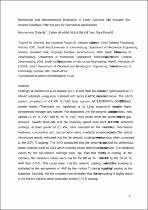 ResearchSpace
ResearchSpace
Mechanical and microstructural evaluation of laser assisted cold sprayed bioceramic coatings: potential use for biomedical applications
JavaScript is disabled for your browser. Some features of this site may not work without it.
- ResearchSpace
- →
- Research Publications/Outputs
- →
- Conference Publications
- →
- View Item
| dc.contributor.author |
Tlotleng, Monnamme

|
|
| dc.contributor.author |
Akinlabi, E

|
|
| dc.contributor.author |
Shukla, M

|
|
| dc.contributor.author |
Pityana, Sisa L

|
|
| dc.date.accessioned | 2015-05-25T10:50:44Z | |
| dc.date.available | 2015-05-25T10:50:44Z | |
| dc.date.issued | 2014-02 | |
| dc.identifier.citation | Tlotleng, M., Akinlabi, E., Shukla, M. and Pityana, S.2014. Mechanical and microstructural evaluation of laser-assisted cold sprayed bioceramic coatings: potential use for biomedical applications. TMS2014, 143rd Annual Meeting and Exhibition, San Diego Convention Center, San Diego, California, USA, 16-20 February 2014, pp 1-20 | en_US |
| dc.identifier.uri | http://hdl.handle.net/10204/7970 | |
| dc.description | TMS2014, 143rd Annual Meeting and Exhibition, San Diego Convention Center, San Diego, California, USA, 16-20 February 2014 | en_US |
| dc.description.abstract | Coatings of commercial pure titanium (CP)-Ti and HAP bio-ceramic were synthesised on Ti-6Al-4V substrate using laser assisted cold spray (LACS) deposition technique. The LACS system comprised of 4.4 kW Nd:YAG laser system, AT-12000HPHV 5000PSI (35 bar) powder feeder (Thermach Inc., Appleton), a De Laval supersonic nozzle and a highly compressed nitrogen gas system. For deposition, the bio-ceramic powder composition, now named 20 wt. %, HAP and 80 wt. %, HAP, was varied while the laser power, the N2 gas pressure, powder feed rate and the scanning speed were kept at constant. The achieved coatings, at laser power of 2.5 kW, were analysed for the microstructures, mechanical hardness, composition and bio-corrosion using available analytical techniques. The optical microscope results indicated that the bio-ceramic coatings were most porous when compared to the (CP)-Ti coating. The XRD concluded that the ceramic coatings had no deleterious phase material such as CaO which typically cause delamination during service. The hardness values for the bio-ceramic coatings were high than that of the (CP)-Ti coating. At the interface, the hardness values were low for the 80 wt. %, HAP followed by the 20 wt. %, HAP then CP-Ti. This could mean that the ceramic coatings are ductile. The bonding is attributed to the entrapment of HAP by the molten Ti during rapid heating/ cooling at the substrate. Similarly, the bio-corrosion test indicated that the ceramic coating is highly active in the Hank’s solution when compared to the (CP)-Ti coating. | en_US |
| dc.language.iso | en | en_US |
| dc.relation.ispartofseries | Workflow;14318 | |
| dc.subject | Laser materials | en_US |
| dc.subject | Composite | en_US |
| dc.subject | Laser-assisted cold spray | en_US |
| dc.subject | Hydroxyapatite | en_US |
| dc.subject | Laser power | en_US |
| dc.subject | Titanium | en_US |
| dc.title | Mechanical and microstructural evaluation of laser assisted cold sprayed bioceramic coatings: potential use for biomedical applications | en_US |
| dc.type | Conference Presentation | en_US |
| dc.identifier.apacitation | Tlotleng, M., Akinlabi, E., Shukla, M., & Pityana, S. L. (2014). Mechanical and microstructural evaluation of laser assisted cold sprayed bioceramic coatings: potential use for biomedical applications. http://hdl.handle.net/10204/7970 | en_ZA |
| dc.identifier.chicagocitation | Tlotleng, Monnamme, E Akinlabi, M Shukla, and Sisa L Pityana. "Mechanical and microstructural evaluation of laser assisted cold sprayed bioceramic coatings: potential use for biomedical applications." (2014): http://hdl.handle.net/10204/7970 | en_ZA |
| dc.identifier.vancouvercitation | Tlotleng M, Akinlabi E, Shukla M, Pityana SL, Mechanical and microstructural evaluation of laser assisted cold sprayed bioceramic coatings: potential use for biomedical applications; 2014. http://hdl.handle.net/10204/7970 . | en_ZA |
| dc.identifier.ris | TY - Conference Presentation AU - Tlotleng, Monnamme AU - Akinlabi, E AU - Shukla, M AU - Pityana, Sisa L AB - Coatings of commercial pure titanium (CP)-Ti and HAP bio-ceramic were synthesised on Ti-6Al-4V substrate using laser assisted cold spray (LACS) deposition technique. The LACS system comprised of 4.4 kW Nd:YAG laser system, AT-12000HPHV 5000PSI (35 bar) powder feeder (Thermach Inc., Appleton), a De Laval supersonic nozzle and a highly compressed nitrogen gas system. For deposition, the bio-ceramic powder composition, now named 20 wt. %, HAP and 80 wt. %, HAP, was varied while the laser power, the N2 gas pressure, powder feed rate and the scanning speed were kept at constant. The achieved coatings, at laser power of 2.5 kW, were analysed for the microstructures, mechanical hardness, composition and bio-corrosion using available analytical techniques. The optical microscope results indicated that the bio-ceramic coatings were most porous when compared to the (CP)-Ti coating. The XRD concluded that the ceramic coatings had no deleterious phase material such as CaO which typically cause delamination during service. The hardness values for the bio-ceramic coatings were high than that of the (CP)-Ti coating. At the interface, the hardness values were low for the 80 wt. %, HAP followed by the 20 wt. %, HAP then CP-Ti. This could mean that the ceramic coatings are ductile. The bonding is attributed to the entrapment of HAP by the molten Ti during rapid heating/ cooling at the substrate. Similarly, the bio-corrosion test indicated that the ceramic coating is highly active in the Hank’s solution when compared to the (CP)-Ti coating. DA - 2014-02 DB - ResearchSpace DP - CSIR KW - Laser materials KW - Composite KW - Laser-assisted cold spray KW - Hydroxyapatite KW - Laser power KW - Titanium LK - https://researchspace.csir.co.za PY - 2014 T1 - Mechanical and microstructural evaluation of laser assisted cold sprayed bioceramic coatings: potential use for biomedical applications TI - Mechanical and microstructural evaluation of laser assisted cold sprayed bioceramic coatings: potential use for biomedical applications UR - http://hdl.handle.net/10204/7970 ER - | en_ZA |





